The Samurai Gardens of Japan: Unveiling their Aesthetic and Philosophy
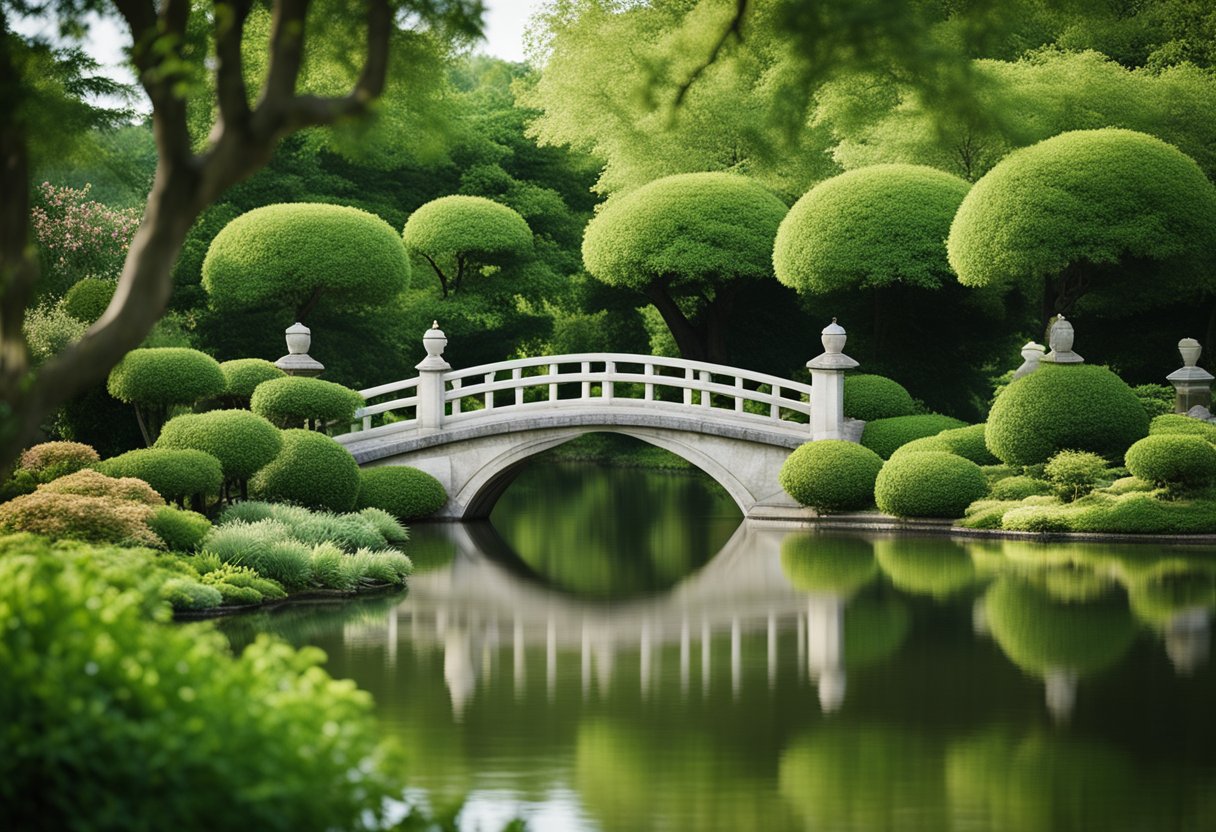
Updated On: April 23, 2024 by Yomna Salah
The Samurai gardens of Japan are a harmonious blend of meticulous aesthetics and deep-rooted philosophy. These gardens are not just landscapes but a silent narrative of the Samurai way of life, conveying messages of simplicity, precision, and the eternal cycle of life and death. Often representing miniaturised natural scenes, they encapsulate the Samurai’s intimate relationship with nature and their pursuit of inner peace and reflection.
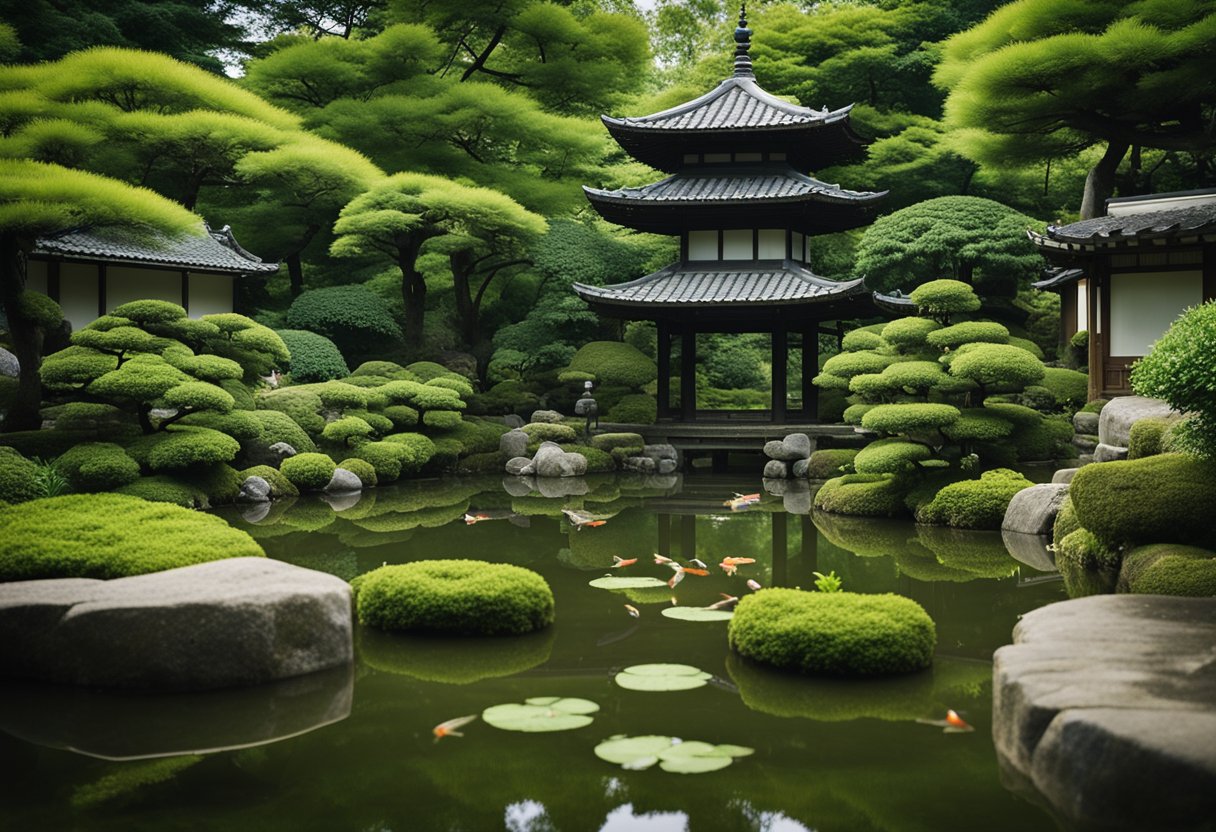
Famed for their deliberate design, Samurai gardens embody a respect for the elements and encourage visitors to contemplate their place within the natural world. Every rock placement, water feature, and plant selection is intentional, creating a tapestry of symbolism that has evolved throughout Japan’s history. They serve as a testament to Japan’s cultural heritage, from the undulating hills mimicking the country’s mountainous terrain to the tranquil ponds reflecting the stillness of mind the Samurai sought to achieve.
Table of Contents
Historical Development of Samurai Gardens
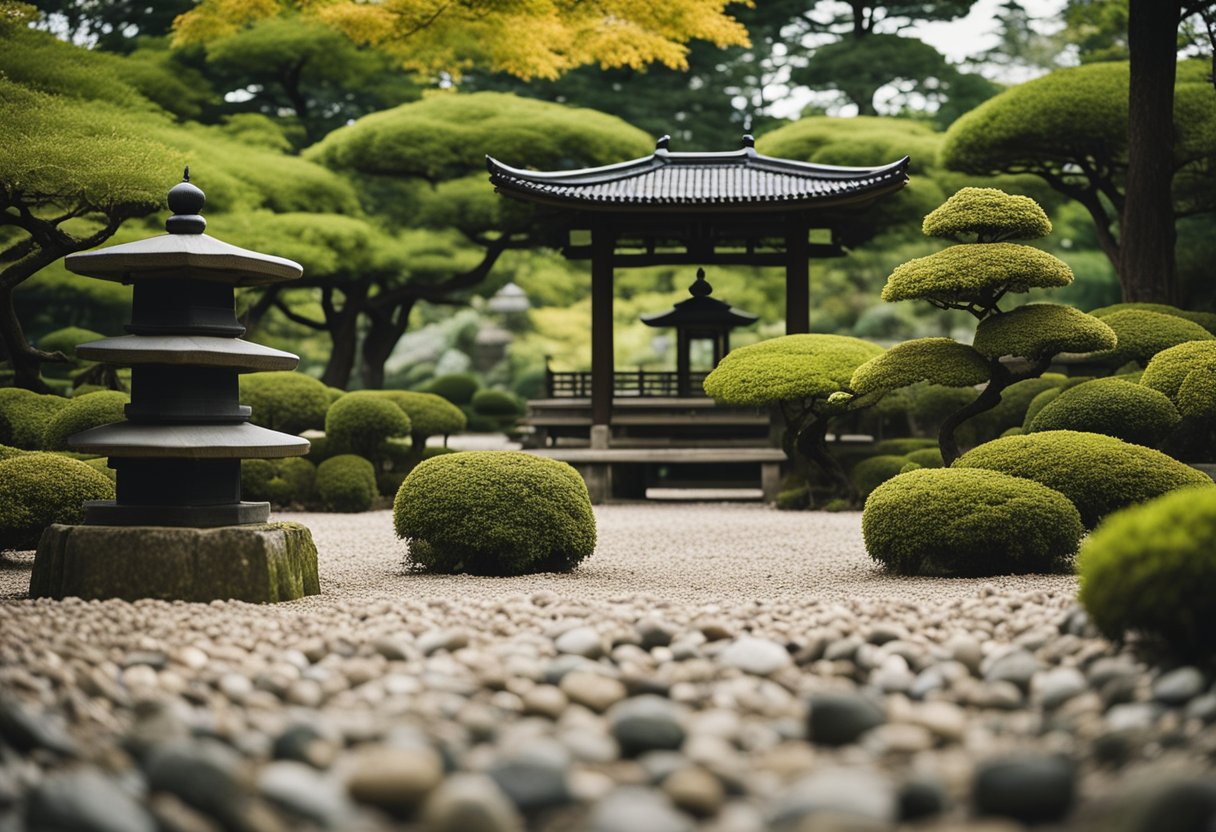
In our journey through Japan’s landscaped past, we uncover the sophistication of Samurai gardens, areas where aesthetics and philosophy harmoniously intertwine. These gardens are not mere ornaments but echo the profound cultural shifts of each historical period.
Heian Period Influence
The Heian Period, spanning from 794 to 1185, witnessed the inception of Japan’s traditional garden design. Aesthetically, these gardens often reflected the ethereal qualities found in Chinese Philosophical Texts, integrating concepts of harmony and balance. Symmetry and geometric layouts often gave way to more asymmetrical designs, spurring garden arrangements that resonated with the aristocracy, including the noble class of Minamoto. An illustrious example of such an aesthetic is the Shinden-zukuri style, with its strolling paths around central ponds and elegantly arranged stones and islands, encouraging contemplation and leisure.
Kamakura to Muromachi Periods
As we transitioned into the Kamakura Period (1185-1333) and through to the Muromachi Period (1336-1573), the gardens began to reflect the evolving cultural climate. The Samurai class, elevating authority, sculpted gardens to encapsulate their power and spiritual leanings. These gardens bore the influence of Zen Buddhism and were designed to serve contemplative purposes, with each element carefully placed to enable reflection and meditation. Dry rock gardens, often found in Zen monasteries, became prominent during the Muromachi Period, providing a stark contrast to the earlier verdant paradises.
Edo Period Evolution
Advancing to the Edo Period (1603-1868), Samurai gardens flourished in diversity and grandeur. During this era, they often embodied ‘borrowed scenery’ (shakkei), where the landscape beyond the garden was integrated into the design, creating an infinite vista. The philosophy of these gardens was immersive, designed for viewers to take a journey, both physical and metaphorical, through meticulously composed scenes that depicted nature’s ephemerality. It’s during this epoch that some of the most iconic gardens were created, including those commissioned by the feudal lords (daimyo) who sought to express serenity and power, a legacy that still resonates in the hearts of those who stroll through their paths today.
Philosophical Foundations
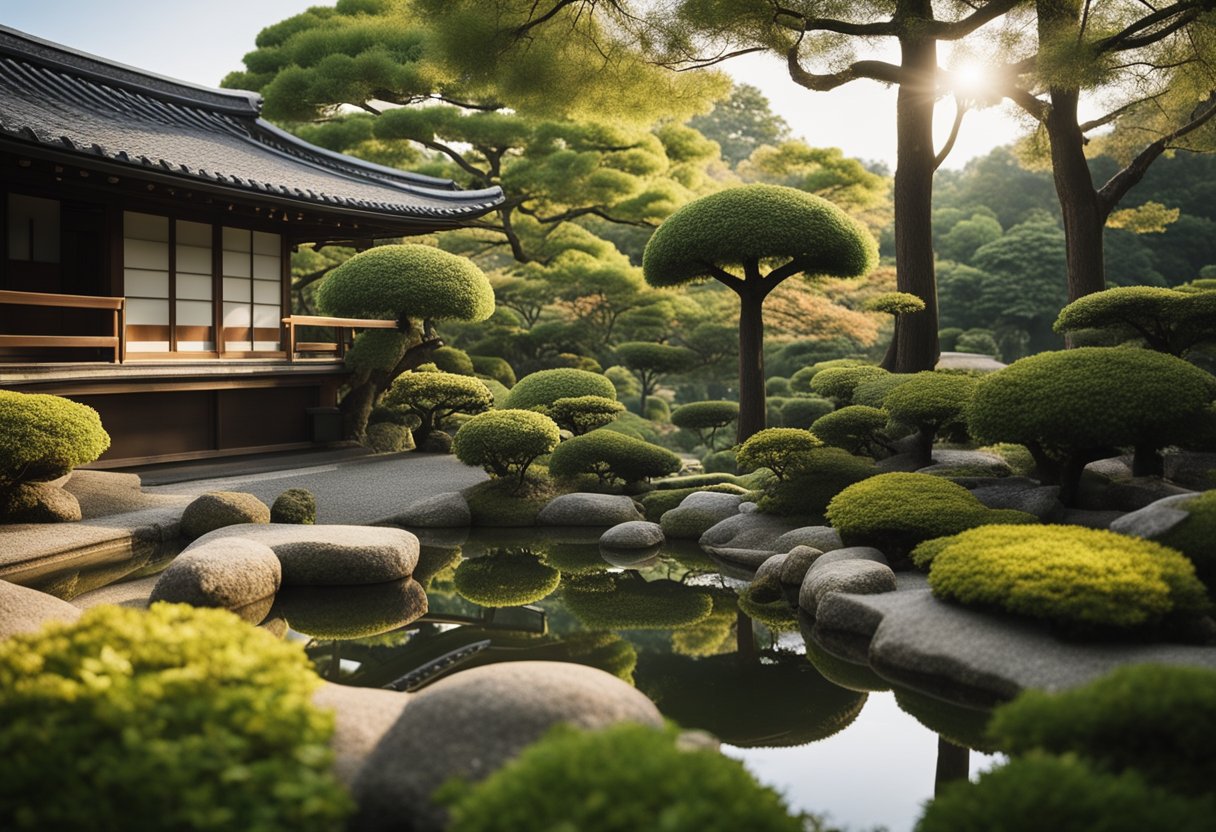
In exploring the samurai gardens of Japan, we uncover a rich tapestry woven from the threads of Zen Buddhism and the ethical code of the samurai, Bushido. These gardens are far more than mere landscapes; they are a physical manifestation of philosophical thought and spiritual discipline.
Zen Buddhism’s Impact
Zen Buddhism has been a cornerstone of Japanese garden design, placing an emphasis on meditation and the search for inner peace. These gardens often feature meticulously placed stones and gravel raked into patterns that represent rippling water, a testament to the Zen focus on simplicity and nature. Each element within a Zen garden has a specific purpose and is a product of careful philosophical consideration aimed at facilitating contemplation and mindfulness.
Teachings of Samurai and the Garden Aesthetics
Bushido, the way of the warrior, greatly influences the aesthetics of samurai gardens. With its roots in Zen Buddhism and Confucianism, Bushido emphasises virtues such as honour, courage, and simplicity. Features in a samurai garden, like the deliberate arrangement of plants and paths, reflect these values, encouraging a disciplined and focused mindset. The connection between the garden’s aesthetic elements and the philosophical teachings helps visitors engage with the principles that guided the lives of the samurai.
Garden Aesthetics and Design Principles

Japanese garden design is underpinned by aesthetics that celebrate the beauty in imperfection, the harmony of borrowed scenery, and the serenity of abstract representations. These principles guide the creation of spaces that invite contemplation and reflection.
Wabi-Sabi and the Beauty of Imperfection
Wabi-sabi is the acceptance of transience and imperfection in garden aesthetics. It finds beauty in the simple, the modest, and the aged. This philosophy is evident in the asymmetrical placement of stones and the use of weathered materials, which remind us that impermanence and flaws are natural and indeed beautiful.
Shakkei and Borrowed Scenery
Shakkei, or borrowed scenery, is the incorporation of existing, surrounding landscape elements into the design of a garden. By aligning garden elements with distant hills, trees, or streams, shakkei extends the garden beyond its physical boundaries, creating a more profound sense of space and harmony with the natural world.
Karesansui and the Abstract Representation
Karesansui gardens, known as Zen or dry landscape gardens, use gravel and rocks to represent water and natural forms. These gardens rely on minimalistic design and are meant to be viewed from a single perspective, encouraging deep meditation. The renowned Sakuteiki, an ancient Japanese gardening manual, offers insights into these abstract yet meaningful design principles.
By adhering to these aesthetics and design principles, we craft gardens that evoke the philosophical concepts of Yūgen and Iki—a sense of profound grace and subtle tastefulness.
Elemental Composition in Samurai Gardens
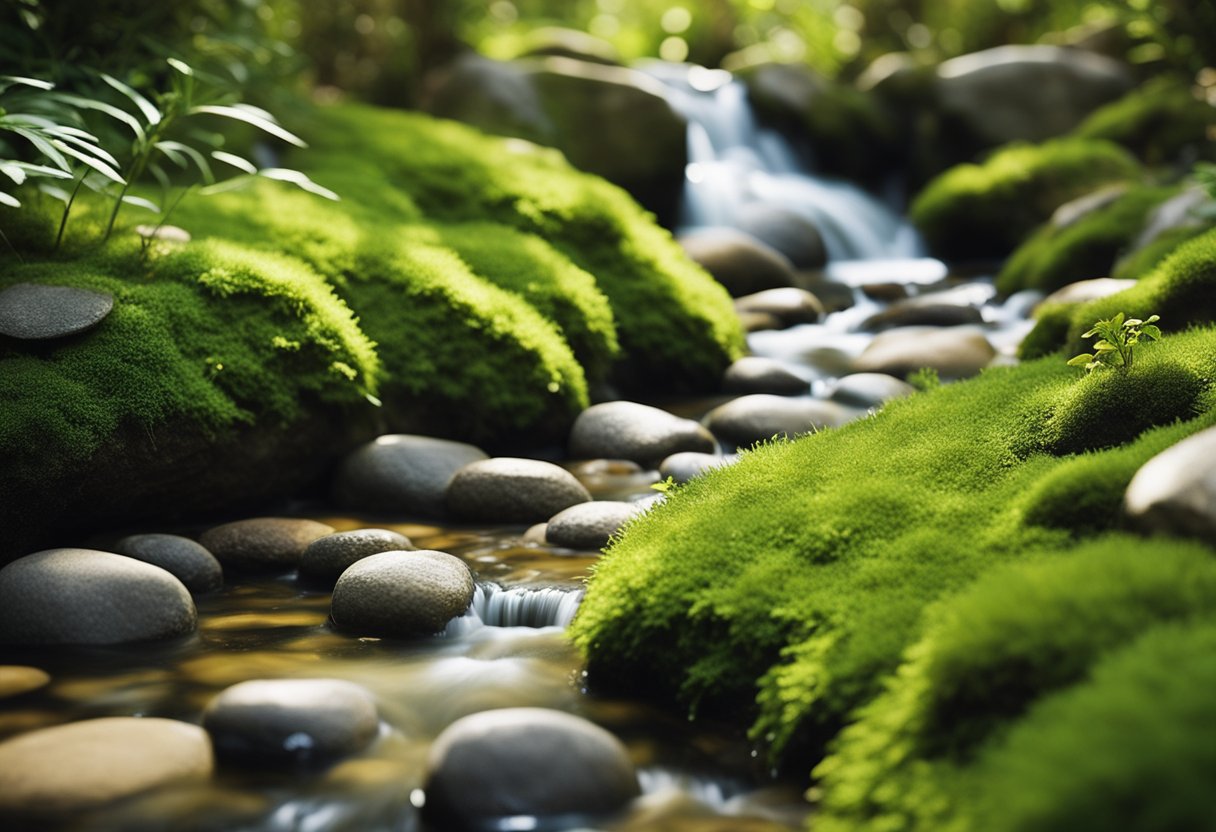
We must recognise that the elemental composition of Samurai gardens is strategically established to promote harmony and reflection. Each feature, whether rocks, water, or plants, serves both an aesthetic and philosophical function.
Symbolism of Rocks
The selection and placement of rocks in Samurai gardens are paramount, embodying the essence of nature and stability. We see rocks acting as mountainous representations or as islands amidst gravel ‘oceans’ in Zen gardens, evoking the rugged landscape of Japan. Their presence infers strength and eternity, with each formation meticulously arranged to bring forth the Zen philosophy of natural beauty and endurance.
Water Elements and Ponds
Water, often in the form of ponds, is a central element representing purity and renewal. The gentle sounds of waterfalls or streams symbolise continuity and the passage of time. In the context of Samurai gardens, water invites tranquillity and deep contemplation, reflecting the fluidity and ever-changing nature of life itself.
The Role of Flora
Flora in these gardens is not a mere backdrop but an integral part of the design, encapsulating the changing seasons and the transient beauty of life. The practice of flower arranging, or Ikebana, influences garden layouts, where plants are chosen and positioned according to shape, colour, and seasonal relevance, often highlighting the beauty of impermanence—a central tenet in Zen Buddhism.
Garden Structures and Accoutrements
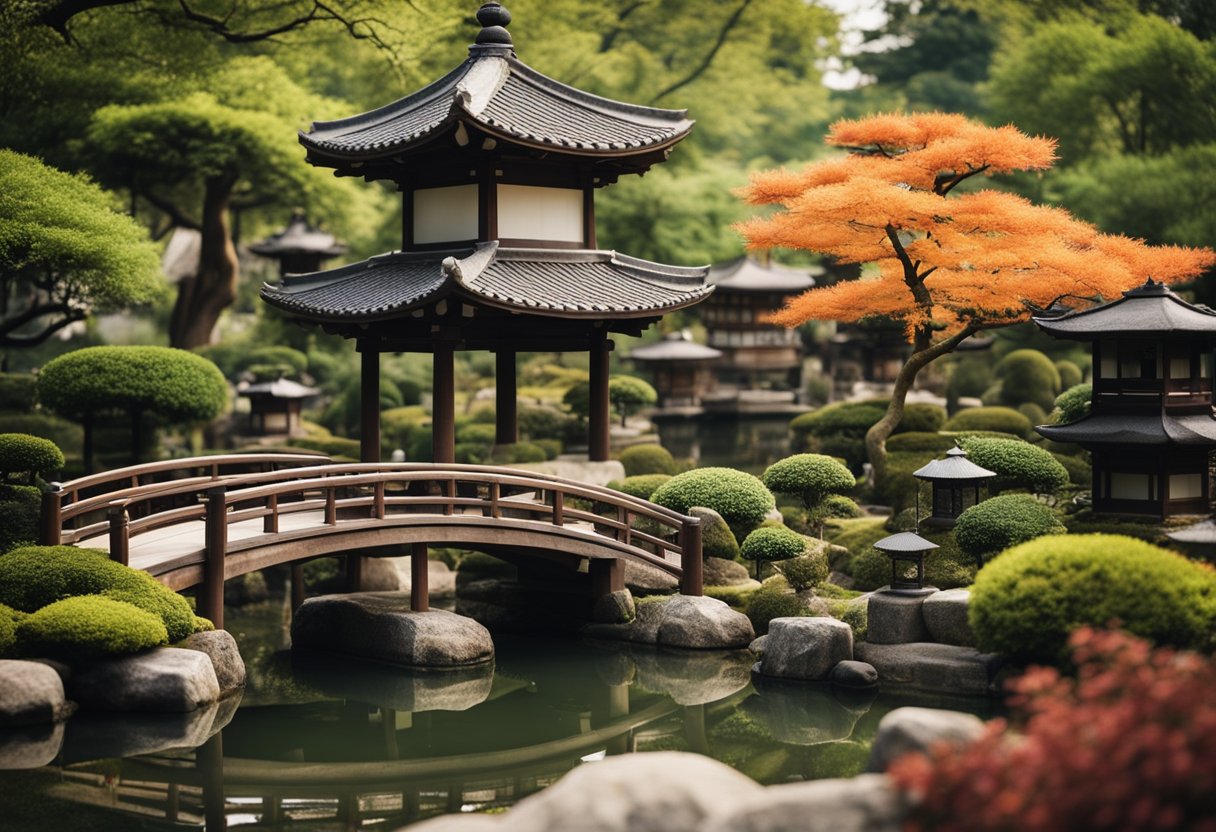
In Japanese gardens, each element is steeped in aesthetic and philosophical meaning, contributing to the overall sense of harmony and peace. Garden structures, such as tea houses and accoutrements like stone lanterns and pathways, are not merely decorative. They are integral to the garden’s spiritual and functional aspects, inviting deep reflection and facilitating the revered tea ceremony.
The Spiritual Significance of Tea Houses
The tea house, or chashitsu, is central to the Japanese Tea Ceremony, a ritualised practice focusing on preparation, serving, and drinking tea. The tea house itself is a bastion of harmony and peace, designed to integrate seamlessly with the surrounding tea garden. Its architecture and ambience encourage a mental transition from the external world to the intimate, tranquil setting necessary for a tea ceremony. As guests traverse the garden to reach the tea house, they symbolically leave their worldly concerns behind, preparing their hearts and minds for the reflective nature of the ceremony.
The Functionality of Stone Lanterns and Pathways
Stone lanterns, known as tōrō, and pathways in a Japanese garden are about function as much as form. These features direct participants through the garden, crafting a journey that fosters mindfulness and anticipation of the tea ceremony ahead. Stone lanterns, often found along the garden’s meandering paths, serve as beacons that illuminate the way, especially as daylight fades. Their soft light enhances the garden’s aesthetics and provides a visual metaphor for enlightenment. Pathways, built from carefully placed stepping stones, encourage a deliberate and contemplative pace, ensuring that guests absorb the tranquil atmosphere and the meticulous harmony intrinsic to the Japanese garden.
By understanding and appreciating these elements, we gain insight into the profound principles that underlie the design and use of Samurai gardens in Japan.
Cultural Practices Related to Gardens
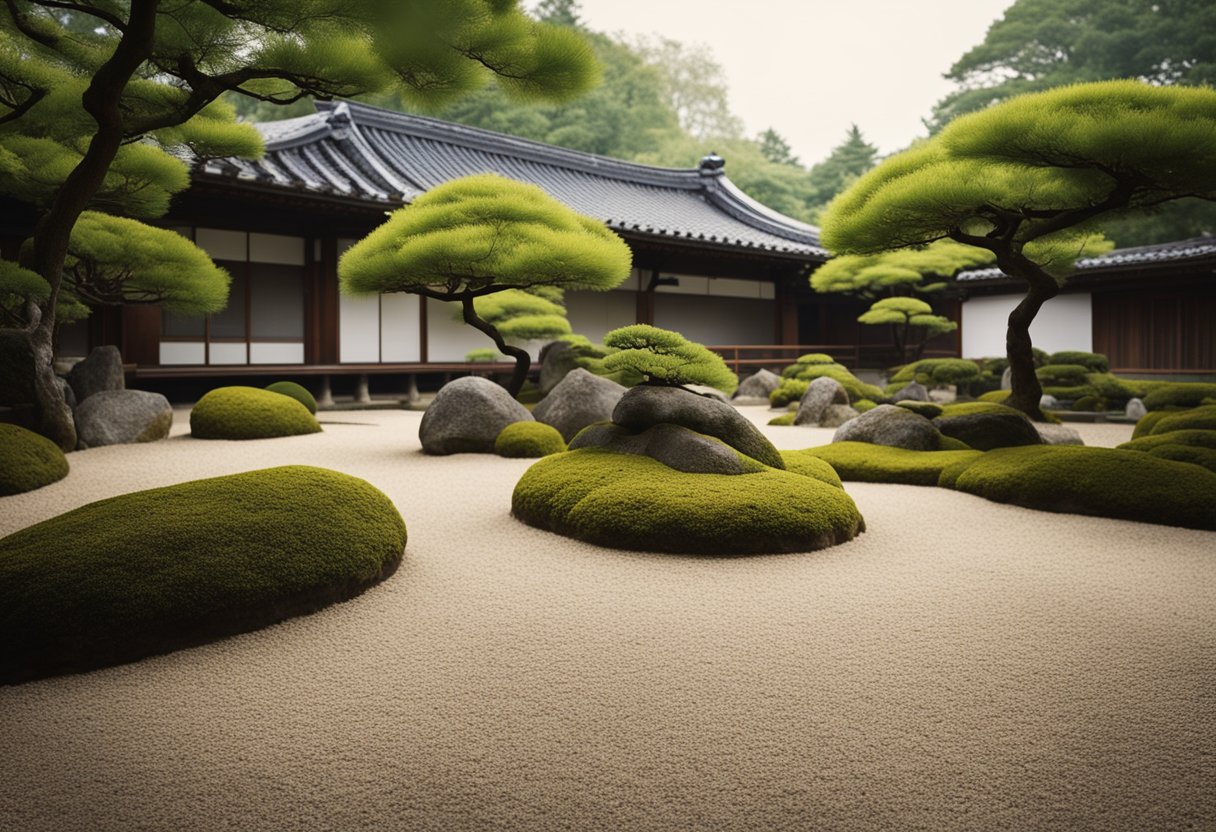
Japanese gardens are deeply intertwined with cultural activities that highlight the nation’s artistic sensibilities and philosophical outlook. Two such practices, essential to grasping the cultural context of these spaces, are the art of the tea ceremony and the discipline of ikebana.
The Art of Tea Ceremony
The Japanese tea ceremony, or ‘chanoyu’, represents a choreographed ritual of preparing and presenting matcha (powdered green tea). Rooted in Zen Buddhism, the ceremony emphasises mindfulness and harmony. It is held within the tranquil setting of a tea garden, called a ‘roji’, which is designed to bring about a sense of peace through its winding pathways and rustic simplicity. Participants cross the roji to reach the tea house, with every element of both the garden and ceremony seeking to enhance the connection between the guest, host, art, and nature.
Ikebana: The Way of Flowers
Ikebana, which translates to “the way of flowers,” is a disciplined art form where nature and humanity are brought together. Evolving from the Buddhist practice of offering flowers at altars, ikebana is now seen as a form of Japanese art encompassing spiritual and artistic dimensions. The arrangement symbolises heaven, earth, and mankind, with each placement carefully considered to achieve balance and harmony. The principles of ikebana influence the aesthetics of Japanese gardens, where the arrangement of stones, trees, and water features echoes the careful composition of these living bouquets.
Samurai Gardens and the Natural World
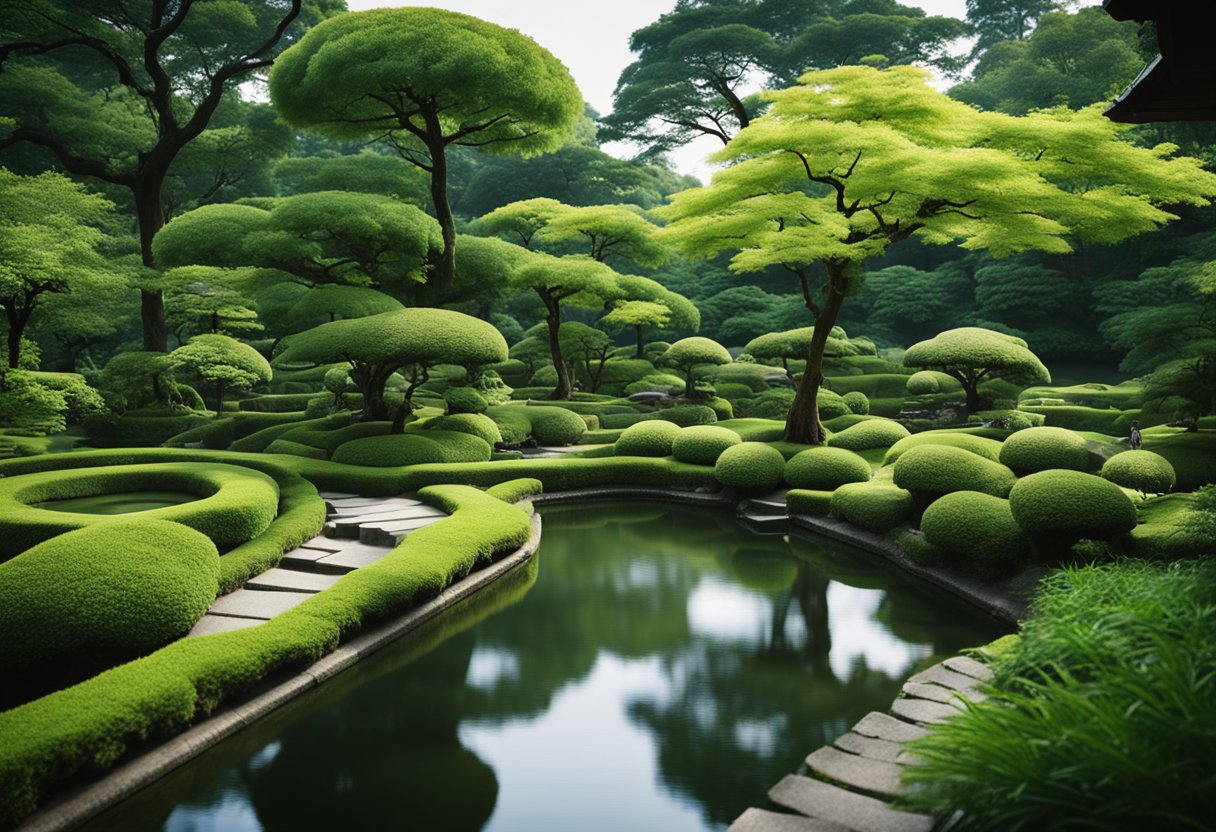
We explore the profound connection between the Samurai gardens of Japan and their representation of the natural world. These spaces blend meticulous design with an aesthetic deeply rooted in philosophical concepts, resonating with the intrinsic beauty of the environment.
Human Connection to Nature and Gardens
In Samurai gardens, every stone placement and water feature is a calculated gesture towards mirroring the natural world. We find a profound respect for nature through the careful emulation of its forms and balance. These gardens serve as a contemplative space where the barriers between humans and the natural environment are subtly dissolved. The interaction here is not one of dominance but of harmony, enabling visitors to reflect upon their own place within the natural realm.
Environmental Aesthetics in Design
The design of Samurai gardens is a manifestation of environmental aesthetics, aiming to capture the essence rather than the exact appearance of nature. Zen gardens, a subset of Samurai gardens, exemplify this with their minimalist, dry landscapes known as kare-sansui, symbolising elements like mountains, rivers, and even the sea through carefully raked gravel and strategically placed rocks. This form of garden design is not just about visual appeal; it conveys deeper philosophical content, encouraging an inner journey in the viewers, and aligning with the tranquillity and order found in the natural world.
Samurai Gardens in the Arts
Samurai gardens have long served as a muse for various art forms in Japan, encapsulating the essence of Japanese aesthetics and philosophy. They are not merely landscapes but also canvases that have inspired profound artistic expressions.
Influence on Painting and Calligraphy
In the realm of painting and calligraphy, samurai gardens have been a potent symbol. The meticulous layouts and elements of these gardens mirror the balance and precision revered in these art forms. For instance, the careful arrangement of rocks and water features within the gardens aligns with the structured yet fluid brush strokes found in traditional Japanese calligraphy, an art where each character carries its own weight and beauty.
Artists have long been drawn to these stylised landscapes, often capturing the seasonal changes in gardens with delicate ink washes and vibrant pigments. The aesthetic principles reflected in the gardens – such as wabi-sabi (the beauty of imperfection) and shakkei (borrowed scenery) – also permeate these art disciplines, informing artworks that are rich in detail and philosophical underpinnings.
Reflections in Literature and Noh Theatre
Samurai gardens have found their echoes within literature and the Noh theatre as well. In classical Japanese literature, the serene beauty of these gardens often serves as a backdrop for tales of honour, love, and the ephemeral nature of life. Poets have woven imagery of these carefully curated landscapes into their verses, using elements of the garden as metaphors to convey deeper emotions and narratives.
Noh theatre, with its minimalistic and symbolic stage design, draws from the same philosophical well. The sparsity of the Noh stage parallels the Zen-inspired spaces of samurai gardens, where every element is laden with meaning and carefully placed to evoke a specific atmosphere or emotion. The Noh plays often reference garden scenes to emphasise themes of nature, the changing seasons, and the inner landscapes of the characters. This deep integration of garden aesthetics within Noh performances highlights the enduring cultural significance of these emblematic spaces.
Preservation and Modern Relevance

As we explore the Samurai Gardens of Japan, we acknowledge not only their historical value but also their enduring influence on modern landscapes. These gardens encapsulate a blend of aesthetic principles and philosophical insights that remain relevant today, both within Japan and as an influence on garden design in Western culture.
Challenges in Maintaining Historical Sites
Japanese gardens, as reflections of the samurai era’s meticulous artistry, face significant preservation challenges. The natural materials — from stone lanterns to wooden bridges — are vulnerable to Japan’s often harsh weather conditions, necessitating constant care. However, the philosophy that underpins these gardens, such as the concept of wabi-sabi, embracing imperfection and transience, often guides the restoration process.
- Weather-related deterioration
- Maintenance of traditional craftsmanship
- Ensuring authenticity in restoration
Influence of Samurai Gardens on Contemporary Spaces
The design principles of Samurai gardens still resonate deeply in contemporary spaces, both in Japan and globally. In modern garden design, the balance of nature and meticulous arrangement borrowed from the Samurai gardens promotes tranquillity and reflection. These traditional aesthetics have subtly permeated Western culture, inspiring minimalist and contemplative garden spaces that encourage a connection with nature.
- Adaptation of traditional aesthetics for modern use
- Influence on Minimalist Design Trends
- Emphasis on contemplative spaces
Educational and Spiritual Aspects
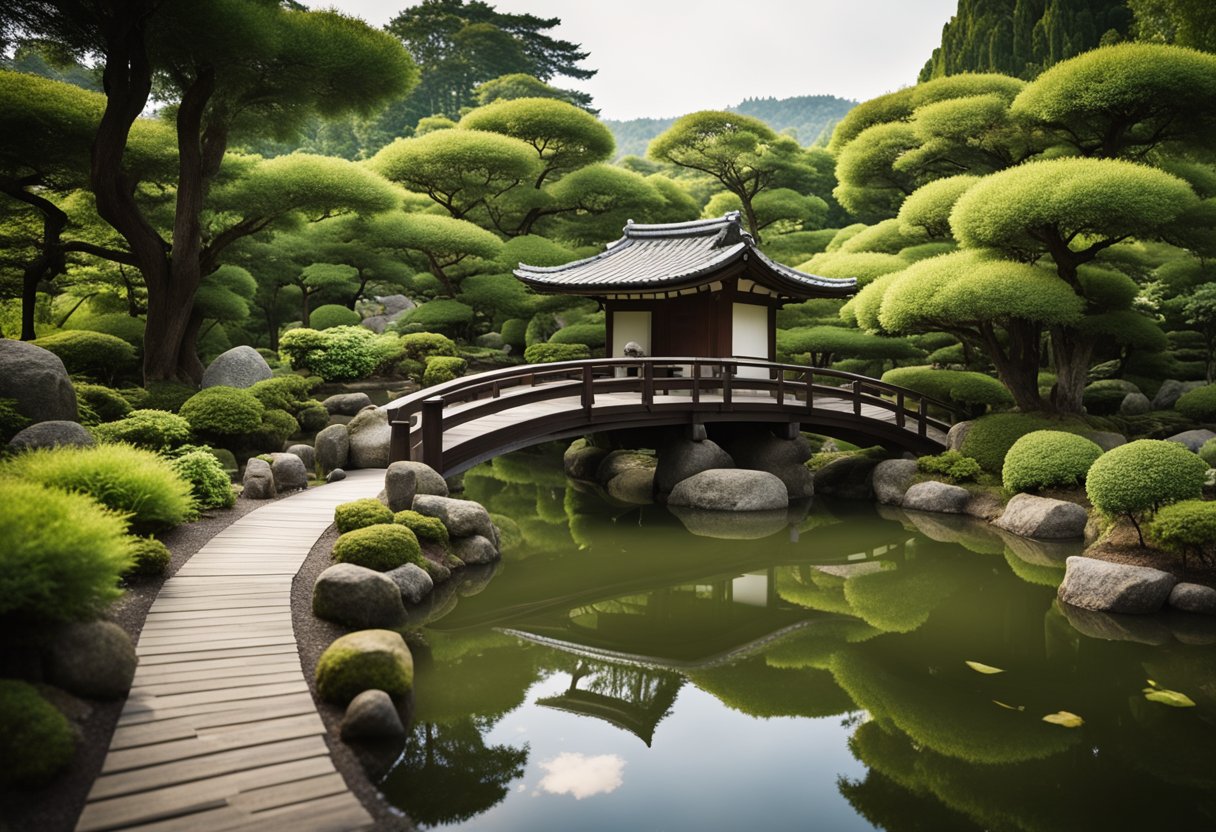
In Japanese gardens, like the Samurai gardens, the intertwining of education and spirituality is pronounced. Here, knowledge and contemplation go hand in hand. Each step through the garden aims to teach visitors about Zen principles and the transient beauty of nature.
Teaching occurs naturally in the garden’s design. Amidst meticulously raked gravel and thoughtfully placed stones, lessons about balance, harmony, and impermanence are imparted. This environment is an open invitation to meditation, encouraging a state of Zazen—sitting meditation—in which one can seek enlightenment and inner peace.
The educational aspect also flows from the legacy of Zen Master Dōgen, who emphasised the importance of practice and learning in the path to spiritual awakening. His teachings continue to resonate within these spaces, reminding us that enlightenment comes through ongoing effort and attentiveness to our immediate experience.
The gardens serve as an embodiment of Zen teachings, promoting spirituality by being living examples of Zen concepts. Individuals often find themselves in a state of mindfulness as they journey through these landscapes—a practice designed to bring the mind into the present moment.
Key Educational and Spiritual Elements in Samurai Gardens:
- Teaching: Implicit lessons on Zen principles
- Zazen: Spaces conducive to seated meditation
- Zen Master Dōgen: Influence on garden philosophy
- Spirituality: Cultivation of mindfulness and self-reflection
Through these gardens, we learn not just with our minds but with all our senses—aspects of Zen Buddhism become tangible, interactive experiences. Admiring their beauty, we are reminded that such gardens are more than just places; they are profound teachers of life’s impermanent, ever-changing nature.
Frequently Asked Questions
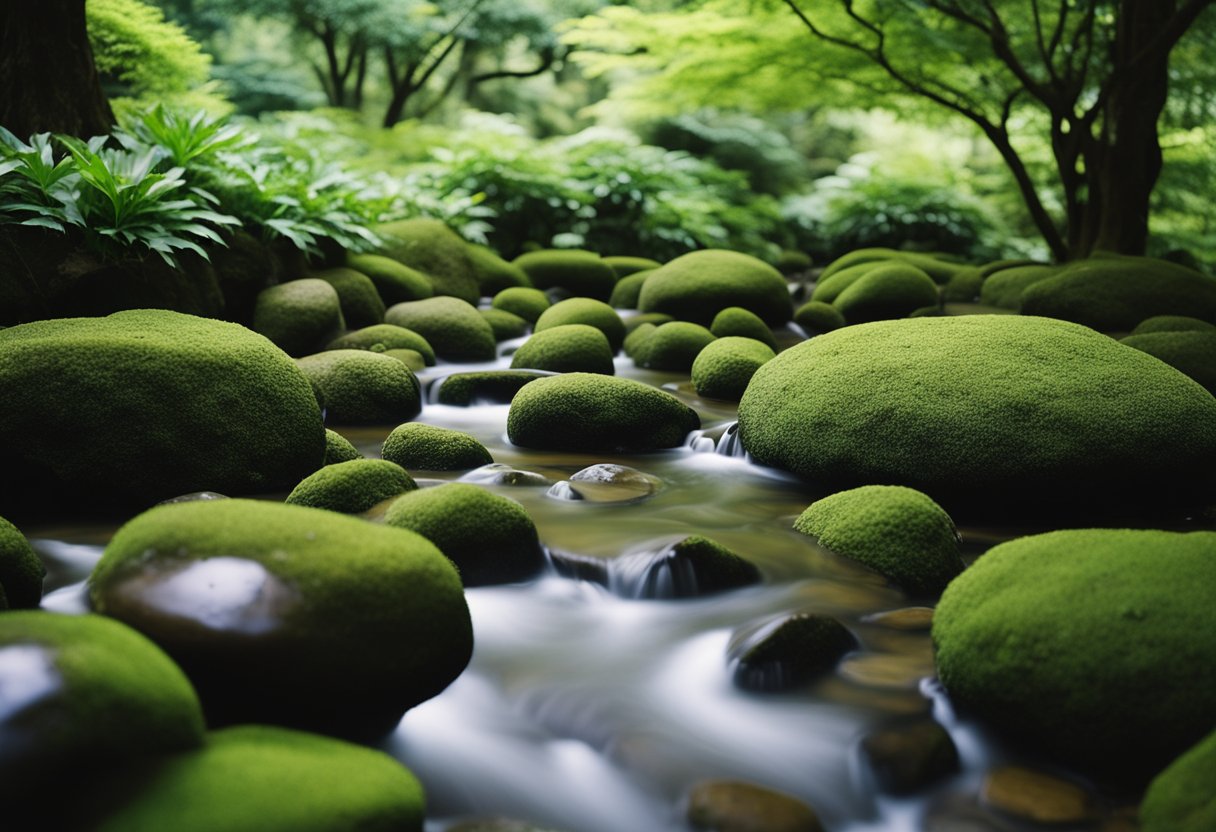
In this section, we’ll answer some of the most common queries regarding the design and philosophy of Samurai-era Japanese gardens.
What are the primary design principles guiding the creation of traditional Japanese gardens?
Traditional Japanese gardens are guided by principles that emphasise natural beauty and harmony. Elements like ponds, streams, rocks, and carefully selected vegetation are arranged meticulously to create a sense of tranquillity and reflect the natural landscape.
In what ways do the aesthetics of Samurai-era gardens reflect the philosophical beliefs of the period?
The aesthetics of Samurai-era gardens often mirror the Zen philosophy’s values of simplicity, meditation, and the quest for enlightenment. The minimalistic designs and symbolic elements encourage introspection and a connection with nature.
How has the history of Japan shaped the evolution of its garden art?
Japan’s garden art has evolved through influences from Shintoism, Buddhism, and Taoism, combined with the specific elements of each historical period, including the Samurai era, which introduced disciplined aesthetic approaches in line with the Samurai’s structured way of life.
What thematic representations are commonly found in gardens associated with the Samurai culture?
Gardens associated with Samurai culture often feature representations of strength, courage, and discipline, with stone arrangements symbolising endurance and meticulously pruned plants reflecting the Samurai’s precision and attention to detail.
How do the elements of a Japanese rock garden convey its underlying philosophical concepts?
A Japanese rock garden uses stones, gravel, and minimal vegetation to create abstract representations of islands, mountains, and flowing water, symbolising the Zen concepts of impermanence, solitude, and the importance of finding beauty in simplicity.
What do Japanese gardens reveal about the cultural values and practices of the Samurai class?
Japanese gardens reveal a culture of restraint, respect for form and order, and a profound connection to the natural world, qualities that were held in high esteem by the Samurai class. These values were expressed through the meticulous care and thoughtful design of their gardens.






